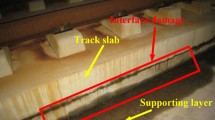Summary
The determination of the safe temperature increase in the rails of a continuously welded track, to prevent lateral buckling is presented. The criterion used is based on the post-buckling equilibrium branches of the track. The range of safe temperature increases is defined asT 0<T L , whereT L is the smallest value of the temperature rise at which a deformed state of equilibrium (thus, a buckled state) becomes possible. The post-buckling equilibrium states are determined analytically. To obtain a consistent formulation of the problem use is made of the principle of virtual displacements and the variational calculus for variable matching points. The obtained formulations are nonlinear, but can be solved exactly. Solutions are presented for four buckled configurations. The results are presented graphically for a typical railroad track presently in use on main lines. The obtained results are compared with the corresponding results of other investigators.
Zusammenfassung
Der zulässige Temperaturanstieg in den Schienen eines kontinuierlich geschweißten Gleises wird bestimmt, um seitliches Ausbeulen zu verhindern. Das verwendete Kriterium basiert auf Nachbeulgleichgewichtskurven des Geleises. Der Bereich des zulässigen Temperaturzuwachses wird definiert mitT 0<T L , wobeiT L der kleinste Wert des Temperaturanstieges ist, bei dem ein verformter Gleichgewichtszustand (im ausgebeulten Zustand) möglich ist. Die Nachbeulgleichgewichtslagen werden analytisch bestimmt. Für eine klare Formulierung des Problems wird das Prinzip der virtuellen Verschiebungen und die Variationsrechnung für variable Endpunkte verwendet. Die erhaltenen Gleichungen sind nichtlinear, können aber exakt gelöst werden. Lösungen werden für vier Beulformen angegeben. Die Ergebnisse sind für eine typische Eisenbahnschiene, wie sie gegenwärtig auf den Hauptlinien verwendet wird, graphisch dargestellt. Die erhaltenen Ergebnisse werden mit entsprechenden Ergebnissen anderer Untersuchungen verglichen.
Similar content being viewed by others
References
Kerr, A. D.: Lateral buckling of railroad tracks due to constrained thermal expansions. — A Critical Survey, in: Railroad Track Mechanics and Technology, Proceedings of a Symposium held at Princeton University, April 21–23, 1975 (Kerr, A. D., ed.). Pergamon Press. (In print.)
Birmann, F.: Neuere Messungen an Gleisen mit verschiedenen Unterschwellungen (New measurements on tracks with different ties, ballast and subgrade). (In German.) Eisenbahntechnische Rundschau6 (1957).
Kerr, A. D.: The effect of lateral resistance on track buckling analyses. Rail International, No. 1 (1976).
Kerr, A. D., El-Aini, Y.: Determination of admissible temperature increases to prevent vertical track buckling. Princeton University Research Report 75-SM-11, December 1975.
Kerr, A. D.: Model study of vertical track buckling. High Speed Ground Transportation Journal7 (1973).
Kerr, A. D.: On the derivation of well posed boundary value problems in structural mechanics. International Journal of Solids and Structures12, No. 1 (1976).
Novozhilov, V. V.: Teoria Uprugosti. Leningrad: Gos. Soyuz. Izd. Sudostroitelnoi Promyshlennosti. 1958. Translated into English as “Theory of Elasticity” by the Israel Program for Scientific Translations, Jerusalem, 1961, OTS 16-11401.
Martinet, A.: Flambement des voies sans joints sur ballast et rails de grande longueur (Buckling of the jointless track on ballast and very long rails). (In French.) Revue Générale des Chemins de Fer, No. 10 (1936).
Mishchenko, K. N.: Besstykovyi Relsovyi Put (The jointless railroad track). (In Russian.) Moscow: Gos. Transp. Zh/D Izd. 1950.
Numata, M.: Buckling strength of continuous welded rail. Bulletin International Railway Congress Association, English Edition, January 1960.
Kerr, A. D.: On the stability of the railroad track in the vertical plane. Rail International, No. 2 (1974).
Pershin, S. P.: Metody rascheta ustoichivosti besstykogo puti (Methods for analyzing the buckling of a jointless railroad track). (In Russian.) Vyp. 147. Moscow: Trudy MIIT. 1962.
Author information
Authors and Affiliations
Additional information
With 12 Figures
Research sponsored by the Federal Railroad Administration, Office of R & D, with the Transportation Systems Center as Program Manager, under Contract DOT-TSC-900 and by the National Science Foundation under Grant ENG 74-19030.
Rights and permissions
About this article
Cite this article
Kerr, A.D. Analysis of thermal track buckling in the lateral plane. Acta Mechanica 30, 17–50 (1978). https://doi.org/10.1007/BF01177436
Received:
Revised:
Issue Date:
DOI: https://doi.org/10.1007/BF01177436




